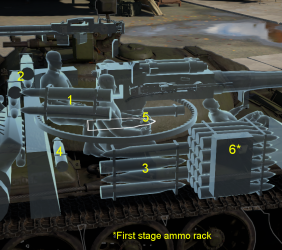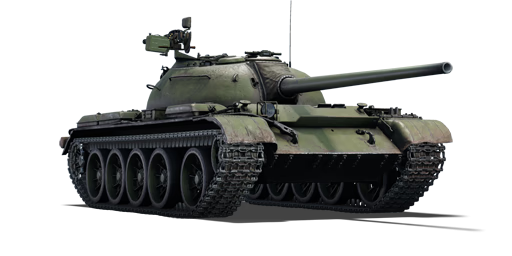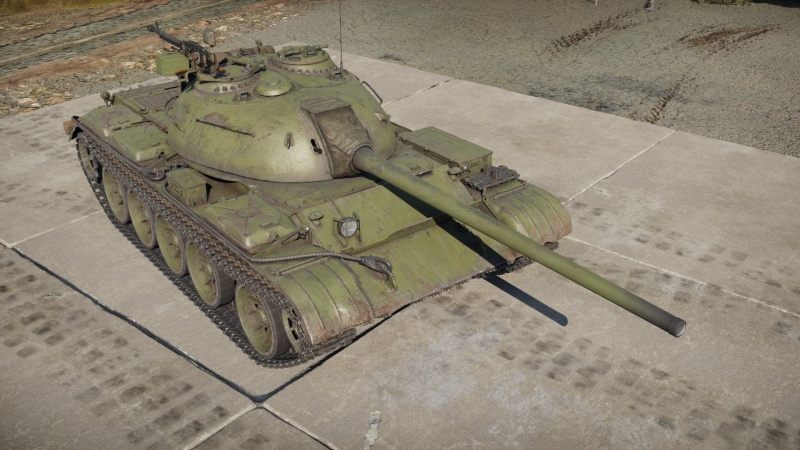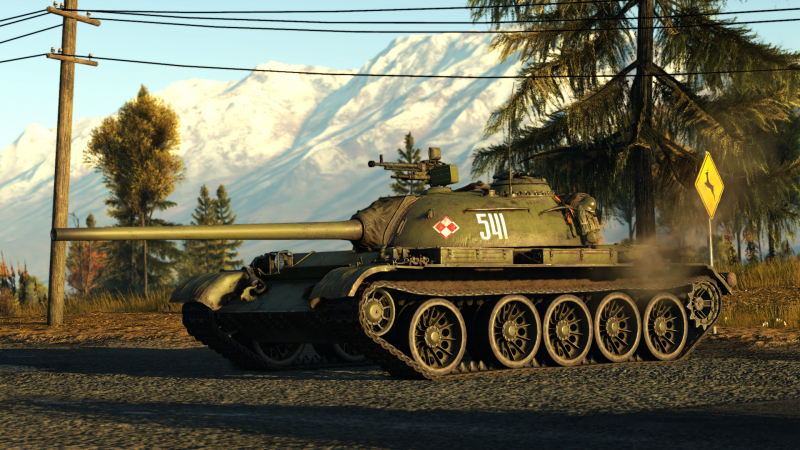T-54 (1951)
| This page is about the Soviet medium tank T-54 (1951). For other versions, see T-54/55 (Family). |
Contents
Description
The T-54 Model 1951 is the third variant of the T-54 main battle tank family. Produced from 1952 to 1954, the T-54 Model 1951 variant used the same familiar, fully egg-shaped turret as the T-54 Model 1949 variant. However, it features a new TSh-2-22 telescopic gunner's sight instead of the old TSh-20 telescopic gunner's sight. It also has an engine exhaust smoke system that creates a temporary smokescreen by injecting vaporized diesel fuel into the exhaust system. This feature was carried over to the T-54, T-55, and T-62 main battle tank families.
Introduced in the Closed Beta Test for Ground Forces before Update 1.41, the T-54 Model 1951 is nearly identical to the previous variant, with the addition of new high-explosive anti-tank fin-stabilised (HEATFS) ammunition capable of penetrating 380 mm of armour. However, since the post-penetration damage is insufficient, it should not be used as the primary ammunition for engagement. The playstyle is very similar to the T-54 Model 1949 variant.
General info
Survivability and armour
The armour of the T-54 leaves nothing to be desired. While it does not get the 120 mm frontal plate of the T-54 (1947), it is one of the strongest frontal plates seen in an early MBT and is able to withstand full calibre solid shots from all nations (Obus de rupture for example, the French solid shot seen in most post war designs such as the Lorraine 40t, AMX-50, etc). However, the armour is nonexistent for HEAT and ATGM which are the main ammunition used in 7.7 to 8.7. The tank is practically immune to low calibre autocannon fire with exception of APDS rounds to the sides (seen in Warrior and AMX-30 DCA).
Armour type:
- Rolled homogeneous armour (Hull, Turret roof)
- Cast homogeneous armour (Turret, Gun mantlet)
| Armour | Front | Sides | Rear | Roof |
|---|---|---|---|---|
| Hull | 100 mm (60°) Front glacis 100 mm (54°) Lower glacis |
80 mm | 45 mm (16°) Upper 30 mm (72°) Lower |
30 mm Front 20 mm Back |
| Turret | 160 mm (14-39°) Turret front 200 mm (4-78°) Gun mantlet |
115 mm (45-50°) Upper 155 mm (10-30°) Lower |
65 mm (9-35°) | 30 mm |
Notes:
- Suspensions wheels and tracks are 20 mm thick.
Mobility
| Game Mode | Max Speed (km/h) | Weight (tons) | Engine power (horsepower) | Power-to-weight ratio (hp/ton) | |||
|---|---|---|---|---|---|---|---|
| Forward | Reverse | Stock | Upgraded | Stock | Upgraded | ||
| Arcade | 56 | 9 | 35.5 | 806 | 992 | 22.7 | 27.94 |
| Realistic | 51 | 8 | 460 | 520 | 12.96 | 14.65 | |
As a relatively heavily armoured tank and part of the Soviet doctrine, the mobility of the T-54 leaves much to be desired. Not only is top speed the lacklustre, but turn rate is not great and reverse speed is mediocre. Overall, the mobility is not the best and should not be relied on to be used to play as a fast paced vehicle. However, the power-to-weight ratio on the T-54 is impressive and is able to climb and move through rough territory with ease as well as push and pull tanks.
Modifications and economy
It's a priority to research Parts and FPE. After that, the player should focus on mobility upgrades or the Horizontal Drive modification, since both mobility and turret rotation are limited when the tank is stock. Also, the 3BK-5 HEATFS shell greatly increases the tank's damage output, and should be considered quite important as well. When grinding the first modifications, Arcade Battles might be more fun, because of faster-paced gameplay and the ability to see all threats. It may also be a good idea to activate 3-5 universal vehicle back-ups to be able to respawn twice in one match. General tips for the stock grind are the same as those for the T-54 (1947), read that article.
Armaments
Main armament
The T-54 has access to the powerful D-10T. As seen in prior vehicles and other vehicles in the tree, the 100 mm is a reliable calibre for all situations with amazing ammunition for all cases. The T-54 (1951) also has access to APDS and HEATFS ammunition for use against everything. Both are impressive ammunition which require little to no practice in terms of use but they do require more trigger discipline and accurate aiming as they make much less spalling that the BR-412D. Despite not having great penetration which will be sort of required when facing heavily armoured targets like the Tiger II, it is able to decimate every vehicle it sees from all angles due to the explosive power. At 7.7 and above, the threats that will be seen (especially Europeans) have little to no armour, able to be easily penetrated by even the BR-412. However, some of the frontal plates of said vehicles are meant to stop the ammunition at certain distances (AMX-30 can stop BR-412 at past 500 m). Using 3BM-8 and 3BK-5 makes frontal engagements easier and with greater results due to the increased armour penetration. But again, they barely cause spalling and will most likely take more than one shot to fully disable and destroy an enemy tank.
| 100 mm D-10T | Turret rotation speed (°/s) | Reloading rate (seconds) | |||||||||||
|---|---|---|---|---|---|---|---|---|---|---|---|---|---|
| Mode | Capacity | Vertical | Horizontal | Stabilizer | Stock | Upgraded | Full | Expert | Aced | Stock | Full | Expert | Aced |
| Arcade | 34 | -4°/+17° | ±180° | - | 9.5 | 13.2 | 16.0 | 17.7 | 18.8 | 9.75 | 8.63 | 7.95 | 7.50 |
| Realistic | 5.9 | 7.0 | 8.5 | 9.4 | 10.0 | ||||||||
Ammunition
| Penetration statistics | |||||||
|---|---|---|---|---|---|---|---|
| Ammunition | Type of warhead |
Penetration @ 0° Angle of Attack (mm) | |||||
| 10 m | 100 m | 500 m | 1,000 m | 1,500 m | 2,000 m | ||
| BR-412 | APHE | 218 | 212 | 189 | 164 | 142 | 124 |
| BR-412B | APHEBC | 218 | 215 | 201 | 184 | 169 | 155 |
| BR-412D | APCBC | 239 | 236 | 220 | 202 | 185 | 170 |
| BR-412P | APCR | 224 | 216 | 186 | 153 | 127 | 105 |
| 3BM-8 | APDS | 336 | 332 | 317 | 299 | 282 | 265 |
| 3BK-5 | HEATFS | 380 | 380 | 380 | 380 | 380 | 380 |
| OF-412 | HE | 27 | 27 | 26 | 24 | 23 | 21 |
| Shell details | ||||||||||||
|---|---|---|---|---|---|---|---|---|---|---|---|---|
| Ammunition | Type of warhead |
Velocity (m/s) |
Projectile mass (kg) |
Fuse delay (m) |
Fuse sensitivity (mm) |
Explosive mass (TNT equivalent) (g) |
Ricochet | |||||
| 0% | 50% | 100% | ||||||||||
| BR-412 | APHE | 895 | 15.88 | 1.2 | 19 | 100.1 | 47° | 60° | 65° | |||
| BR-412B | APHEBC | 895 | 15.88 | 1.2 | 19 | 100.1 | 48° | 63° | 71° | |||
| BR-412D | APCBC | 887 | 15.88 | 1.2 | 19 | 100.1 | 48° | 63° | 71° | |||
| BR-412P | APCR | 1,050 | 8.53 | - | - | - | 66° | 70° | 72° | |||
| 3BM-8 | APDS | 1,415 | 4.13 | - | - | - | 75° | 78° | 80° | |||
| 3BK-5 | HEATFS | 900 | 12.38 | 0.05 | 0.1 | 1,240 | 65° | 72° | 77° | |||
| OF-412 | HE | 900 | 15.6 | 0.2 | 0.1 | 1,460 | 79° | 80° | 81° | |||
| Smoke shell characteristics | ||||||
|---|---|---|---|---|---|---|
| Ammunition | Velocity (m/s) |
Projectile mass (kg) |
Screen radius (m) |
Screen deploy time (s) |
Screen hold time (s) |
Explosive mass (TNT equivalent) (g) |
| 3D3 | 880 | 15.6 | 16 | 5 | 25 | 50 |
Ammo racks

| Full ammo |
1st rack empty |
2nd rack empty |
3rd rack empty |
4th rack empty |
5th rack empty |
6th rack empty |
Visual discrepancy |
|---|---|---|---|---|---|---|---|
| 34 | 33 (+1) | 28 (+6) | 24 (+10) | 23 (+11) | 21 (+13) | 1 (+33) | No |
Notes:
- Shells are modeled individually and disappear after having been shot or loaded.
- Rack 6 is a first stage ammo rack. It totals 20 shells and gets filled first when loading up the tank.
- This rack is also emptied early: the rack depletion order at full capacity is: 6 - 1 - 2 - etc. until 5.
- Full reload speed will be realized as long as shells are available in the ready rack 6. If the ready rack is empty, a penalty to reload speed will occur.
- Simply not firing when the gun is loaded will move ammo from racks 1-5 into rack 6. Firing will interrupt the restocking of the ready rack.
- If you pack 28 (+6) shells, it will keep the turret empty of ammo.
- If you pack 21 (+13) shells, it will fill only the frontal ready rack.
Machine guns
| 12.7 mm DShK | ||||
|---|---|---|---|---|
| Mount | Capacity (Belt) | Fire rate | Vertical | Horizontal |
| Pintle | 250 (50) | 600 | -4°/+82° | ±180° |
| 7.62 mm SGMT | ||||
|---|---|---|---|---|
| Mount | Capacity (Belt) | Fire rate | Vertical | Horizontal |
| Coaxial | 3,500 (250) | 600 | - | - |
Usage in battles
The T-54 (1951) is practically the same tank as the T-54 (1949), it has the same armour as the T-54 (1949) and the only difference is the addition of the new HEATFS round capable of going through 380 mm of armour (the War Thunder community generally accepts the T-54 (1951) as having the best ammunition overall). Again, the new round should be taken as a back-up option for the most armoured enemies, while the BR-412D should remain the main round.
The T-54 (1951) is simply the better tank than the T-54 (1949), because it has the same armour, and the only difference is the addition of HEATFS round, which penetrates through 380 mm. (Read the T-54 (1947) and the T-54 (1949) articles, as they cover the T-54 playstyle).
Major gameplay differences from the T-54 (1949) (Read the T-54 (1947) and the T-54 (1949) articles prior to reading this!)
- You can now penetrate all vehicles that you can see.
- If the map is very big, and you are forced to snipe, you may prefer to take APDS ammunition because it's much easier to aim.
Pros and cons
Pros:
- Improved turret shape and armour thickness, with no shot-traps (Same turret as the T-54 (1949))
- Lighter than the 1947 model, with improved mobility
- Wide ammunition selection, including 380 mm penetration 3BK-5 HEATFS and powerful APHE rounds
- Well-sloped hull glacis plate, resistant to most full-bore AP rounds
- Roof-mounted DShK heavy machine gun for use against aircraft or light vehicles
Cons:
- Unstabilised main gun and very slow turret traverse make it vulnerable to being flanked in close combat
- Relatively low rate of fire
- Small magazine size of the DShK heavy machine gun
- Weaker hull armour than the 1947 model
- Poor penetration with APHE rounds
History
The T-54 mod. 1951 was the final product of the T-54 family and the transition to early T-55 models. It featured the exact same hull, gun, NBC systems and fire control systems of the previous T-54 but with the TSh-2-22 telescopic gunner's sight. The mod. 1951 featured a turret redesign which removed the turret side undercuts, replaced radio with a new R-113 radio, reduced weight as the extra 20 mm has been removed, additional fuel tanks, fume extractor and addition of the TDA smoke generating system.
| Archive of the in-game description | |
|---|---|
|
The new 1951 tank model received a cast semi-spherical turret without shot traps and with improved traverse sealing and an apparatus for attaching a minesweeper. Its two SG-43 machine guns were replaced with a 7.62 mm SGMT machine gun. The T-54's main armament remained as before - a 100 mm D-10T cannon with a 56 calibre barrel length. This weapon was developed in the No. 9 artillery factory's design bureau under the direction of F.F. Petrov. The 100 mm cannon's armour-piercing round was able to penetrate a 125 mm thick vertical armour plate at a range of 2,000 m. After the Second World War, improved variants of this tank served for forty years after the basic model was developed. From 1946, all the characteristics of the T-54 and its variants surpassed those of foreign medium tanks, and its weapon had the best armour-piercing properties. In total, 7,009 of them were made between 1952 and 1955.The T54 Mod. 1951 became widespread outside the USSR's borders and was licensed for production in Poland, Czechoslovakia and China. Its Chinese variant was designated Type 59. Tanks of this type were used in a multitude of armed conflicts in the 20th century. These vehicles are still in service in many countries in Asia and the Middle East. A disadvantage of the tank was the hull layout it inherited from the T-44. It ensured the Soviet tank's advantages over its foreign counterparts, but also restricted opportunities for further increasing the tank's defences, particularly against the new 90 and 105 mm high-explosive anti-tank warheads and armour-piercing subcalibre rounds. The unstabilised tank cannon's accuracy and rate of fire were too low when firing on the move. The T-54's transmission and undercarriage restricted opportunities to increase its mobility after installing a more powerful weapon or increasing its armour. | |
Media
- Skins
- Videos
See also
Links to the articles on the War Thunder Wiki that you think will be useful for the reader, for example:
- reference to the series of the vehicles;
- links to approximate analogues of other nations and research trees.
External links
Paste links to sources and external resources, such as:
- topic on the official game forum;
- other literature.
| Kharkov Design Bureau for Mechanical Engineering named after A. A. Morozov | |
|---|---|
| Light Tanks | |
| BT-5 | BT-5 · RBT-5 |
| BT-7 | BT-7 · BT-7M · BT-7A (F-32) |
| Medium Tanks | |
| T-34-76 | T-34 (Prototype) · T-34 (1940) · T-34 (1941) · T-34 (1st Gv.T.Br.) · T-34 (1942) · T-34E STZ · T-34E |
| T-34-57 | T-34-57 · T-34-57 (1943) |
| T-34-85 | T-34-85 (D-5T) · T-34-85 · T-34-85E |
| T-34-100 | T-34-100 |
| T-44 | T-44 · T-44-100 · T-44-122 |
| Main Battle Tanks | |
| T-54 | T-54 (1947) · T-54 (1949) · T-54 (1951) |
| T-64 | T-64A (1971) · T-64B |
| Export/Captured | |
| T-34 | ▀T 34 747 (r) · ␗T-34 (1943) · ␗Т-34-85 (S-53) |
| See Also | Uralmashzavod · Uralvagonzavod |
| USSR medium tanks | |
|---|---|
| T-28 | T-28 (1938) · T-28 · T-28E |
| T-34-76 | T-34 (Prototype) · T-34 (1940) · T-34 (1941) · T-34 (1st Gv.T.Br.) · T-34 (1942) · T-34E STZ · T-34E |
| T-34-57 | T-34-57 · T-34-57 (1943) |
| T-34-85 | T-34-85 (D-5T) · T-34-85 · T-34-85E |
| T-34-100 | T-34-100 |
| T-44 | T-44 · T-44-100 · T-44-122 |
| T-54 | T-54 (1947) · T-54 (1949) · T-54 (1951) |
| T-55 | TO-55 · T-55A · T-55AM-1 · T-55AMD-1 |
| T-62 | T-62 · T-62M-1 |
| T-64 | Object 435 · T-64A (1971) · T-64B |
| T-72 | T-72A · T-72AV (TURMS-T) · T-72B · T-72B (1989) · T-72B3 · T-72M2 Moderna |
| T-80 | T-80B · T-80U · T-80UD · T-80UK · T-80UM2 · Т-80U-Е1 · T-80BVM · Object 292 |
| T-90 | Т-90А · T-90M |
| Trophies/Lend-Lease | |
| Germany | ▂T-III · ▂T-V |
| Great Britain | ▂МК-IX "Valentine" |
| USA | ▂M3 Medium · ▂M4A2 |






